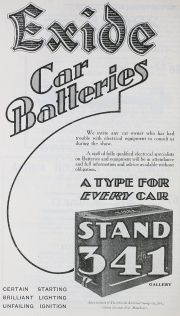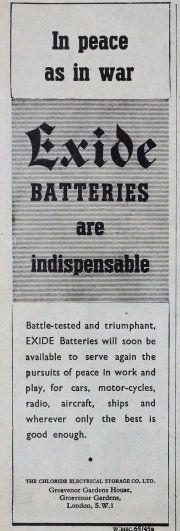Exide: Difference between revisions
No edit summary |
No edit summary |
||
| Line 1: | Line 1: | ||
[[Image:Im090427B-Exide.jpg|thumb| Advertising Sign. ]] | [[Image:Im090427B-Exide.jpg|thumb| Advertising Sign. ]] | ||
[[Image:ImHaynes-Exide.jpg|thumb| Advertising Plaque. ]] | [[Image:ImHaynes-Exide.jpg|thumb| Advertising Plaque. ]] | ||
[[Image:Im1920RedBook45.jpg|thumb| 1920. ]] | |||
[[Image:Im1920IEV-Chloride.jpg|thumb| 1920. Ironclad-Exide. ]] | [[Image:Im1920IEV-Chloride.jpg|thumb| 1920. Ironclad-Exide. ]] | ||
[[Image:Im19200103A-Elec.jpg|thumb| January 1920. Exide.]] | [[Image:Im19200103A-Elec.jpg|thumb| January 1920. Exide.]] | ||
Revision as of 09:44, 2 April 2021























































Batteries and accumulators
The Electric Storage Battery Company, which would one day become Exide Technologies, was founded in the USA in 1888 by W.W. Gibbs, an executive at a gas company, who had seen the potential of electricity as a source of lighting. He purchased the patents of Clement Payen, a French inventor who advanced electrical storage, and began transforming those ideas into reliable commercial products.[1]
See also Wikipedia entry.
1920 October. Chloride exhibited Ironclad Exide batteries for road vehicles at the Commercial Motor Exhibition at Olympia[2]
1938 Exide Company. D. P. Dunne is Chairman, E. C. McKinnon is Chief Engineer
Post-WWII Exide low tension accumulators and Drydex high tension batteries sold for use in radios (see adverts).
1989 Chloride sold the Exide Europe automotive battery business[3]
See Also
Sources of Information
- ↑ [1] Exide Technologies website
- ↑ The Engineer of 22nd October 1920 p400
- ↑ The Times, May 24, 1989

